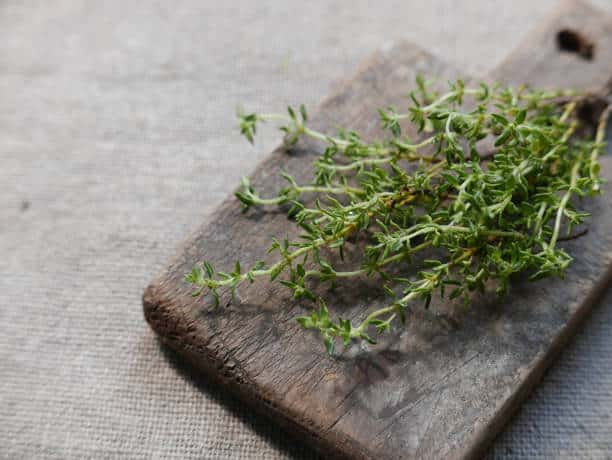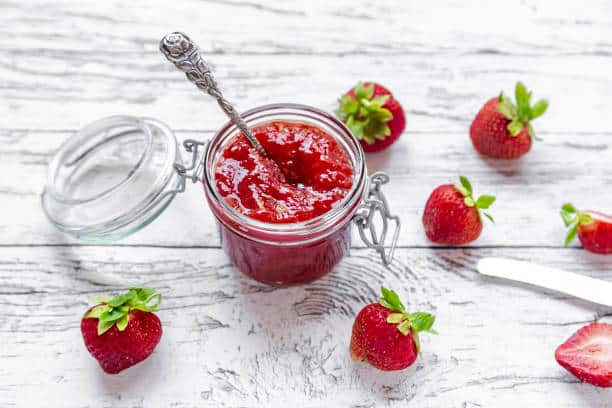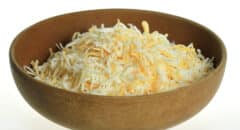
You may know thyme as an aromatic herb with a distinctive flavor. It can add to the overall taste of a dish, but most people consider it to be optional. However, with its potential health benefits, you might start to think differently. Thyme is a great source of certain nutrients and has impressive antimicrobial as well as anti-inflammatory properties that can make a huge difference to your health.
10 Impressive Health Benefits of Thyme
1. It May Reduce Cholesterol
According to a recent study on animals, thyme extract may significantly lower your heart rate if you have high blood pressure. The research suggests that the extract reduces low-density cholesterol and triglyceride levels in your body while raising the high-density cholesterol that’s good for you. As a result, the low-density lipoproteins (LDL) won’t build up in your heart to increase your risk of heart issues.
2. It May Improve Circulation
A teaspoon of thyme contains about one percent of the recommended daily intake (RDI) of iron. Though that doesn’t sound like much, the combination of iron and its other nutrients is thought to encourage the synthesis of much-needed red blood cells. With healthy red blood cells, you may have increased blood circulation and oxygenation to your vital organs.
3. It May Improve Digestive Health
Thyme may help your digestive system in multiple ways. It contains volatile oils that can relieve stomach cramps while also reducing the production of excessive gas and flatulence. It may also help to ease stomach pain. Researchers suggest that these effects may be why people often recommend thyme tea for people who are dealing with stomach issues such as indigestion, gas, and bloating.
4. It May Help With Respiratory Issues
Thyme has antibacterial and anti-inflammatory properties that can be helpful when you’re having respiratory problems. It can remove phlegm and mucus from your respiratory passages while also soothing your throat so you don’t cough as often. It can reduce inflammation, so you can breathe more easily and fight the growth of bacteria that can make an illness worse. Drinking thyme tea when you’re sick can also help to alleviate congestion, persistent asthma symptoms, and blocked sinuses.
5. It May Help With Anemia
As mentioned previously, a teaspoon of thyme contains one percent of your RDI for iron. Iron is essential to the production and maintenance of healthy red blood cells, so when you don’t have enough, this can lead to anemia. If you include thyme in multiple meals, it’s easy to add to your iron intake. This can be helpful for people who are dealing with anemia.
6. It May Ease Menstrual Cramps
Thanks to its antispasmodic properties, thyme may help to reduce your menstrual cramps. It can also help with the discomfort that may accompany menstruation, as well as other issues such as bloating.
7. It May Promote Healthy Bones
Dried thyme contains small quantities of Vitamin K, calcium, iron, and manganese. These nutrients are essential to the formation of bone and usually lower your risk of developing bone disorders.
8. It May Boost Heart Health
Thyme contains antioxidants like lutein, zeaxanthin, and thymonin, which can protect the heart from harmful free radicals that can cause cell mutations. Additionally, the herb contains potassium and manganese, which can be highly beneficial to your cardiovascular system. Potassium helps to relax your blood vessels while also reducing the effects of sodium. Manganese acts as an antioxidant, so it protects your heart from oxidative stress.
9. It May Boost The Immune System
Thyme contains Vitamin C, which is known to boost your immune system. This is partly because Vitamin C promotes the development of white blood cells, and these are vital to the immune system’s job of fighting infection. This vitamin also supports collagen development, which in turn helps with cell repair, muscle development, tissue repair, and the maintenance of healthy blood vessels.
10. It May Help to Fight Cancer
Although more research is needed, studies show that one of the essential oils in thyme may have significant anti-cancer properties. Carvacrol may be able to prevent the growth of tumorous cells in specific types of illness, such as liver and colon cancer.
RELATED: The Amazing Benefits of Thyme Tea
5 Great Recipes to Try
While thyme is generally safe to eat, it’s important to note that a few people can experience an allergic reaction to it. This is especially likely if you’re allergic to similar plants like basil, sage, oregano, or lavender. Signs of an allergic reaction include skin sensitivity after touching the leaves as well as nausea, vomiting, diarrhea, and heartburn after consuming the herb. If you’re not worried about allergies, then here are some tasty recipes to try out!

1. Thyme and Basil Roast Pork
Servings: 8
Ingredients
- 1 tablespoon all-purpose flour
- 2 teaspoons dried basil
- 2 teaspoons dried thyme
- 2 teaspoons ground cinnamon
- 1-½ teaspoons salt
- ½ teaspoon pepper
- 1 boneless pork loin roast (3 to 4 pounds)
- 2 tablespoons canola oil
- 1 medium apple, cut into wedges
- 1 medium onion, cut into wedges
- 1 medium lemon, cut into wedges
- 1 fresh rosemary sprig
Method:
- Preheat oven to 325°. In a small bowl, mix flour, basil, thyme, cinnamon, salt, and pepper; rub over pork.
- In a large skillet, heat oil over medium-high heat. Brown roast on all sides. Place roast in a shallow roasting pan, fat side up. Arrange apple and onion around roast. Squeeze lemon juice from 1 wedge over pork; add lemon wedges to pan. Place rosemary over pork.
- Roast 1 to 1-1/2 hours or until a thermometer reads 145°. Remove roast, onion, and apple to a serving platter; tent with foil. Let stand 15 minutes before slicing.

2. Thyme-Baked Apple Slices
Servings: 6
Ingredients
- 4 cups apple cider
- ¼ cup butter, cubed
- 8 large Braeburn apples (about 4 pounds)
- 3-½ teaspoons minced fresh thyme, divided
Method:
- Place cider in a large saucepan. Bring to a boil; cook until liquid is reduced to 2/3 cup, 18-20 minutes. Remove from heat; stir in butter.
- Peel and cut each apple into eight wedges. In a large bowl, toss apples with 1/4 cup of the reduced cider and 3 teaspoons thyme. Transfer to a foil-lined 15x10x1-in. baking pan. Bake 10 minutes.
- Drizzle with remaining reduced cider. Bake until tender, 12-15 minutes longer. Sprinkle with remaining thyme.

3. Shrimp Asparagus Pasta
Servings: 2
Ingredients
- 3 ounces uncooked angel hair pasta
- ½ pound uncooked shrimp (16-20 per pound), peeled and deveined
- ¼ teaspoon salt
- ⅛ teaspoon crushed red pepper flakes
- 2 tablespoons olive oil, divided
- 8 fresh asparagus spears, trimmed and cut into 2-inch pieces
- ½ cup sliced fresh mushrooms
- ¼ cup chopped seeded tomato, peeled
- 4 garlic cloves, minced
- 2 tablespoons chopped green onions
- ½ cup white wine or chicken broth
- 1-½ teaspoons minced fresh basil
- 1-½ teaspoons minced fresh oregano
- 1-½ teaspoons minced fresh parsley
- 1-½ teaspoons minced fresh thyme
- ¼ cup grated Parmesan cheese
- Lemon wedges
Method:
- Cook pasta according to package directions. Meanwhile, sprinkle shrimp with salt and pepper flakes. In a large skillet or wok, heat 1 tablespoon oil over medium-high heat. Add shrimp; stir-fry until pink, 2-3 minutes. Remove; keep warm.
- In same skillet, stir-fry the next 5 ingredients in remaining oil until vegetables are crisp-tender, about 5 minutes. Add wine and seasonings. Return shrimp to pan.
- Drain pasta; add to shrimp mixture and toss gently. Cook and stir until heated through, 1-2 minutes. Sprinkle with Parmesan cheese. Serve with lemon wedges.

4. Chicken Stew
Servings: 6
Ingredients
- ⅓ cup all-purpose flour
- ½ teaspoon salt
- Dash pepper
- 1-½ pounds boneless skinless chicken breasts, cut into 1-inch pieces
- 3 tablespoons butter
- 1 medium onion, sliced
- 3 celery ribs, sliced
- 2 medium potatoes, peeled and cut into 3/4-inch cubes
- 3 medium carrots, cut into 1/4-inch slices
- 1 cup chicken broth
- ½ teaspoon dried thyme
- 1 tablespoon ketchup
- 1 tablespoon cornstarch
Method:
- In a large shallow dish, combine the flour, salt, and pepper. Add chicken, a few pieces at a time, and turn to coat.
- In a large skillet, melt butter; cook chicken until juices run clear. Add onion and celery; cook for 3 minutes. Stir in potatoes and carrots.
- In a small bowl, combine the broth, thyme, ketchup, and cornstarch; stir into skillet. Bring to a boil. Reduce heat; cover and simmer for 15-20 minutes or until the vegetables are tender.

5. Strawberry Thyme Jam
Servings: 9 ½ pint containers
Ingredients
- 5 cups crushed strawberries (about 3 pounds)
- ½ teaspoon butter
- 1 package (1-3/4 ounces) powdered fruit pectin
- 7 cups sugar
- 1 tablespoon minced fresh thyme
Method:
- In a Dutch oven, combine strawberries and butter. Stir in pectin. Bring to a full rolling boil over high heat, stirring constantly. Stir in sugar; return to a full rolling boil. Boil and stir for 1 minute. Immediately stir in thyme.
- Remove from the heat; skim off foam. Ladle hot mixture into nine hot half-pint jars, leaving 1/4-in. headspace. Remove air bubbles and adjust headspace, if necessary, by adding hot mixture. Wipe rims. Center lids on jars; screw on bands until fingertip tight.
- Place jars into canner, ensuring that they are completely covered with water. Bring to a boil; process for 10 minutes. Remove jars and cool.
If you haven’t been using thyme in your meals, you may be missing out on some wonderful health benefits. Fortunately, you can easily incorporate thyme into your diet with a few good recipes.








